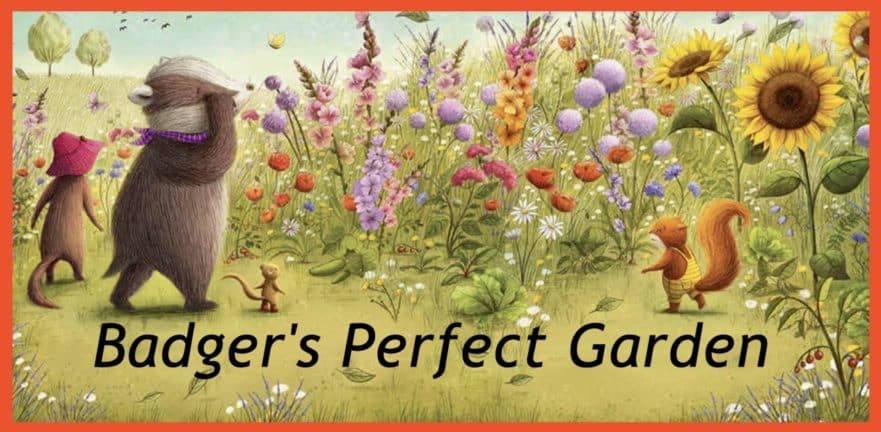This is a perfect story to share with our children at any time, but especially with a little gardener at springtime. Perhaps it will inspire you and your little helpers to plant your own perfect garden!
***********************
BADGER’S PERFECT GARDEN
 Marsha Diane Arnold – Author
Marsha Diane Arnold – Author
Ramona Kaulitzki – Illustrator
It is spring. Badger has dozens of jars of seeds that he saved from last summer to plant the “perfect garden.”

His friends Red Squirrel, Weasel, and Dormouse help him by raking and clearing the ground, marking the rows with string, and making holes for the seeds. They celebrate their efforts with muffins and mulberry juice.



Over the next three days…
Damp weather accelerated from showers to a heavy downpour! Badger was unable to rescue his precious seeds from washing away. Badger tried to distract himself from his sorrow with chores and projects and naps…
Time passes and one sunny summer day…
Badger’s friends rushed to tell him he has the perfect garden after all; the seeds just found new places to grow.


*******************************
*******************************

PLANTING A SPRING GARDEN
Top Crops for Children
Although there are many crops suitable for our young gardeners, these are relatively easy to grow, have short growing seasons, and are fun to harvest.
1. Sunflowers
A must for a child’s garden, plant just one or two, since they take a lot of room. Sunflowers will sprout in one week, become a small seedling in two weeks, and should be 2′ tall in a month. In eight weeks, the buds will flower revealing hundreds of seed kernels. Be sure to grow ‘confectionery’ sunflowers, the type grown for food. They will dry naturally in the late summer sun; the seeds, rich in protein and iron, can be roasted for snacks. Save a few for next summers’ planting.
2. Lettuce/mescluns
Greens are a quick and reliable crop to give the child fast results, and also a good way to interest kids in salads. Lettuce likes part shade; keep soil moist especially during the first two weeks. The seeds will germinate in 7-10 days; growing season is 40-50 days. You can grow ‘head’ (space 8″ apart) or ‘leaf’ (space 4″ apart) varieties; the leaf varieties will mature sooner, about 30-35 days.
3. Radishes
Radishes bring quick results for the young gardener, germinating in 3-10 days, and with a very short growing season of 20-30 days. They can be planted closely, 4-6″ apart. Plant in cool weather for a mild radish, or hot weather for a hotter radish.
4. Snow peas
Snow peas are a quick-growing early crop, and fun for kids to eat right off the vine. They take about 10 days to germinate and mature in about 60 days. Peas prefer cooler, partially shaded locations in the garden; they should be sown closely, about 1″ apart at most. Snow peas are popular because the pod is edible and since they are a dwarf plant they can be grown without a trellis.
5. Cherry tomatoes
Gotta have ’em! These may be the most fun crop for a child, aside from strawberries. Plant in full sun and use seedlings rather than planting from seed. Put in a 2′ stake alongside each seedling; they need to be tied loosely to stakes as they get taller. Add lots of compost. Water at ground level, trying to keep leaves dry. Growing season is 50-75 days. Cherry tomatoes can also be grown in containers.
6. Nasturtiums
These flowers are easy to grow and yield results quickly, which encourages the young gardener. Nasturtiums bloom about 50 days after the seeds are planted, with orange, yellow and red flowers. They prefer sunny, dry locations and do well in poor soil. Choose the shorter varieties for garden beds. Nasturtiums are also pest resistant, which ensures a successful planting. The flowers are also edible, and can be used to add colour to a fresh garden salad.
7. Bush beans
Fast, easy, high yield and, because they do not grow tall, they are easy for kids to harvest. Bush beans germinate in 4-8 days, and mature in 40-65 days. It’s best to plant a small patch, then another in a few weeks. This will extend the harvest. When choosing seeds, select the “low bush” varieties because these will be easier for children to harvest. Plant closely spaced, about 4″ apart. Grow in direct sun; water the soil but try to keep the leaves dry. Bush beans don’t need poles or trellises to grow.
8. Carrots
Carrot seeds can be sown directly into soil and prefer cooler temperatures. They can be slow to germinate, so be patient. Carrots will mature in about 60 days.The soil should be free of rocks and easy for the carrot to grow ‘down’. Keep well-watered and thin to every 3″ because crowding will produce foliage but no root. Small varieties are recommended for children, as they’re easier to grow and more fun to eat.
9. Potatoes
A ‘never-fail’ crop, you can plant red or white potato varieties with equal success, though red will mature faster. Children seem to favor this variety. Cut seed potatoes into chunks with at least two ‘eyes’ per chunk. Plant in furrows, about 12-15″ apart, with eyes pointing upward. Mound soil up around plant as it grows; harvest when plant collapses.


